Text
A TRIP TO JAPAN

We recently flew from Milan to Tokyo for a 12-day holiday in Japan. The trip was organised by an Italian tour operator for a group of 12 people.
All in all it was a pleasant experience, firstly beacause Japan is a marvellous country and then beacause the group was well assorted: 3 young couples on their honeymoon, a middle-aged couple, and two mature ladies of our age.
From Milan to Tokyo we had an adventurous flight but at last we reached the Japanese capital.

If you visit Japan neither in April (cherry blossom) nor in mid-October (foliage) it won’t be crowded and two days in Tokyo are good enough to enjoy shopping in Shibuya, taste an ice-cream or pancake in Harajuku and visit both the Meiji Shintoist Temple and the Kannon Buddhist one without queuing. Moreover, as soon as you enter the beautiful park of the Meiji Temple, you breathe absolute peace.


Worth visiting is the nearby city of Nikko, where the Shikyo Bridge and the Futarasanjin are a World Heritage Site.
In the following days we had two nice excursions, the first one from Magome to Tsumagotwo, where you walk for 8 km in the ancient street that three centuries ago connected Tokyo to Kyoto.


The second walk was in Takayama, a beautiful small town in the mountains.
In the evening, though, we were quite disappointed: the dinner based on the famous Hida meat, booked from Italy for 300 euros each, we found out we could buy there for 30 euros.
We consoled ourselves at the Mercure Hida, where we had the pleasant surprise to get a complimentary access to their onsen (thermal SPA), wearing nice kimonos provided by the hotel.

The following day we went to Shirakawago - by the way, in all our trips by bus or train we were accompanied by absolutely well-organised, guides speaking Italian, provided by MTJ - where we witnessed the most beautiful village we have ever seen; then in Kanazawa we went to the Samurai Noumura house and its splendid garden Kenrouken.
We spent the night in Kanazawa at the Onyado Nono, where we enjoyed another marvelous onsen for free.

Then it was Kyoto, the former Japanese capital, where we spent the last 3 days

Here is the tea ceremony, followed by a tour of the ancient city of Higashiyama.

Then we visited the bamboo forest, the rocks garden and the Ryoanji Temple (World Heritage Site)
We then went to Nara, where, at the Todai-ji, we admired the biggest bronze Buddha in the world, and we had a nice walk in the park that hosts 1200 deer.


The last stop of our journey was the Osaka Kansai airport (designed on an island by Renzo Piano)
5 notes
·
View notes
Text

ORO PURO di Fabio Veronesi, Mondadori (437 pag. € 20)
Consiglio la lettura di questo romanzo.
Palos, Spagna, 1492.
Nuto, sedicenne, è al porto. Ha appena perso la mamma che amava immensamente. E' confuso e si imbarca accidentalmente su una nave, la Santa Maria, con a bordo l'Ammiraglio Colombo che sta partendo per le Indie attraverso l'Oceano Atlantico.
In 3 grandi capitoli, Andata, Esplorazione e Ritorno, Veronesi ci racconta la scoperta dell'America attraverso gli occhi, la mente e il cuore di un ragazzo.
Nuto sa scrivere, cosa rara per quel tempo, così diventa lo scrivano di Cristoforo, che ogni giorno gli detta le esperienze di questo avventuroso viaggio per conto dei reali di Spagna.
Estratto del cap.53
"Il mondo è una musica. Chi la dirige non lo so, ma ogni cosa e ognuno di noi suona la sua parte...ma ognuno da sé vuol dir poco, singoli strumenti che vibrano al ritmo di un'unica musica smisurata."
PURE GOLD by Fabio Veronesi, Mondadori (437 pag. €20)
I recommend reading this novel.
Palos, Spain, 1492
Nuto, 16 years old is at the port. His beloved mother has just passed away. He is confused and accidentally boards a ship, the Saint Mary, where the Admiral Cristoforo Colombo is leaving for the Indies across the Atlantic Ocean.
In 3 great chapters, Outward, Exploration and Return, Veronesi tells us the discovery of America through the eyes, mind and earth of a boy.
Nuto can write, which was rare for that time, and so he becomes Cristoforo's scribe, who every day dictates him the experiences of this adventurous trip on behalf of the Spanish Royals.
Excerpt from chapter 53
"The world is music. I don't know who is the director, but everything and everyone sings his part... but each one for himself means little, individual instruments vibrating to the rhythm of a single boundless music"
1 note
·
View note
Text
Finalmente l’Argentina
L’ho sognata per anni, prima e dopo il corona virus.
Finalmente siam partiti, Giampiero ed io.
In primis Buenos Aires: il cuore pulsante di un paese grande quasi 3 milioni di km².
Nella parte nord della città abbiamo visitato i ricchi quartieri di Palermo
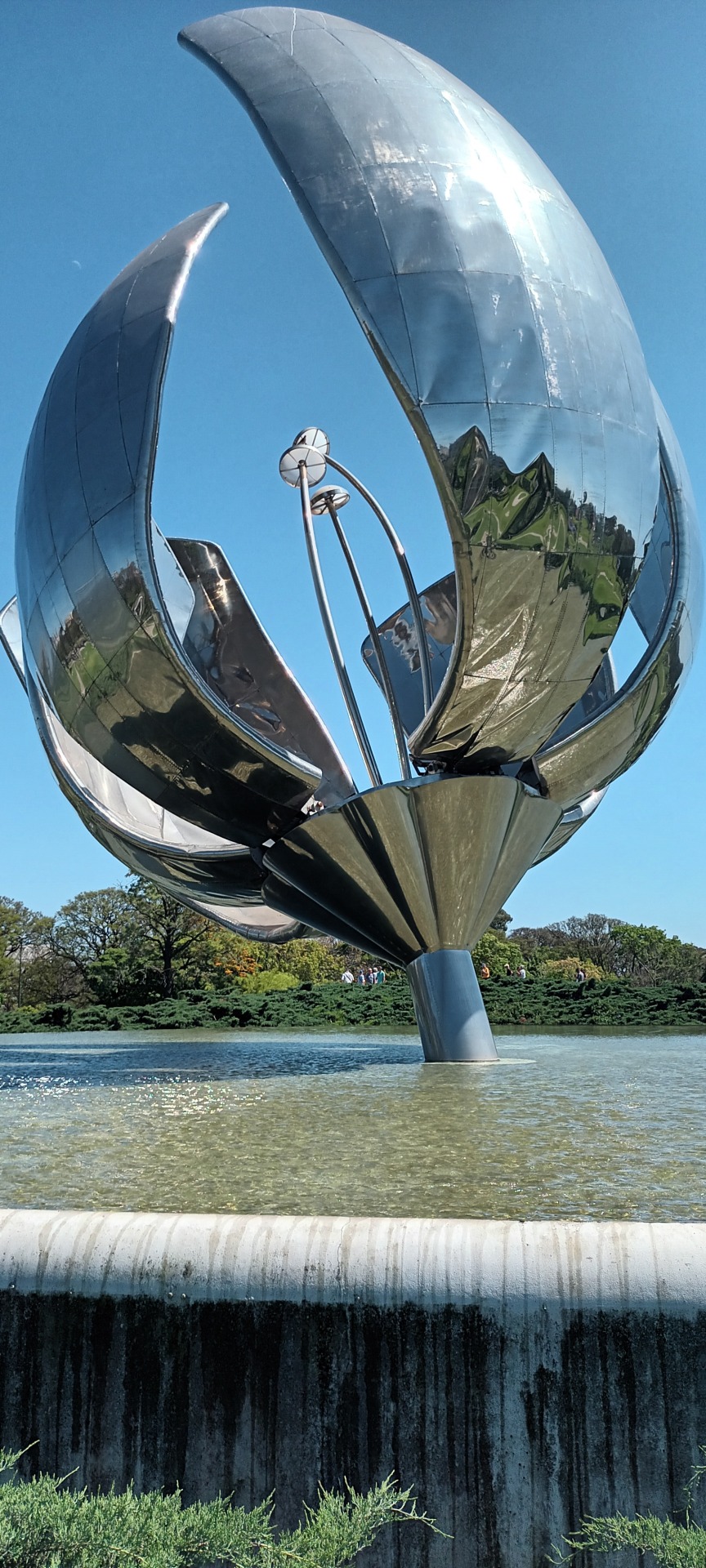

e di Recoleta, nel cui cimitero riposa Eva Peron.
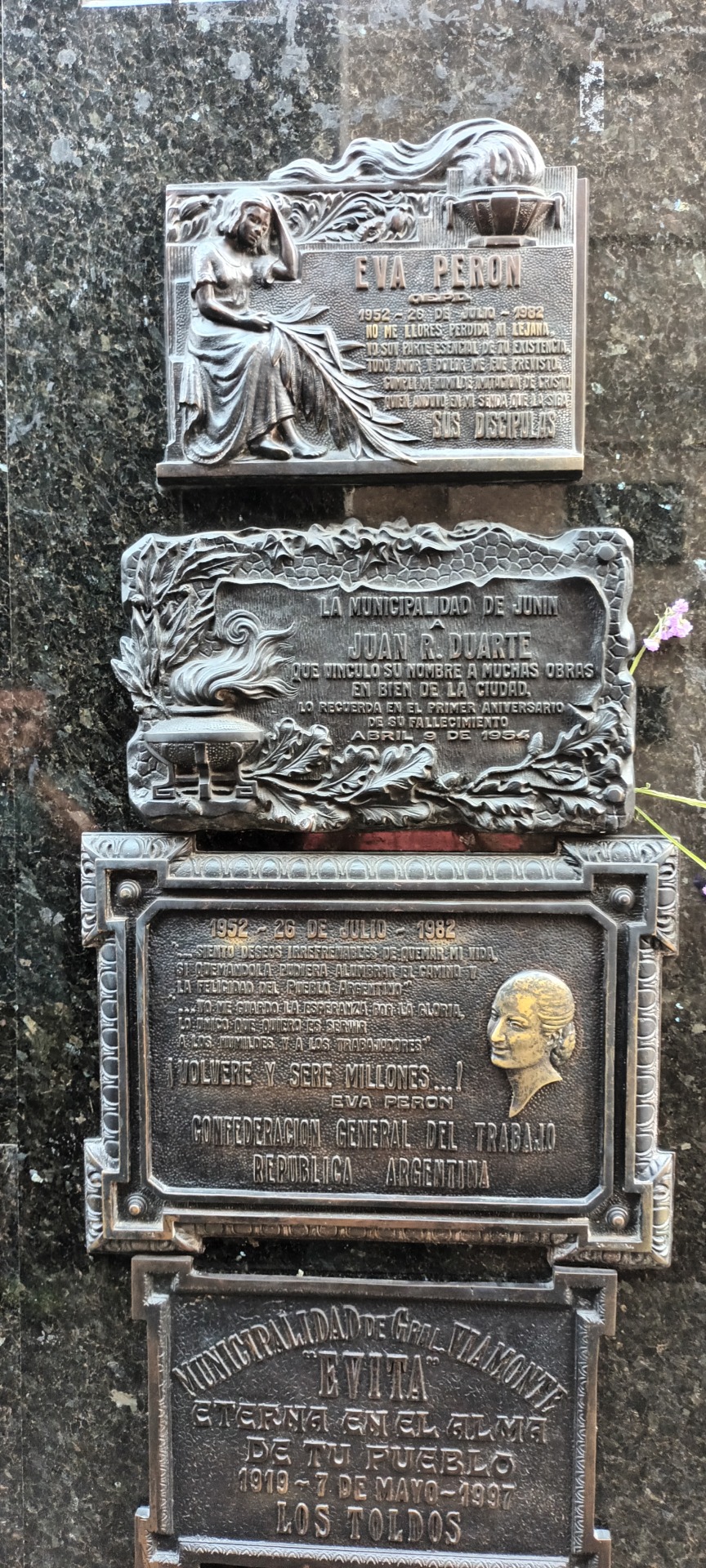
Poi Plaza de Mayo con la Casa Rosada, il Parlamento e la Catedral, da cui proviene Papa Francesco.
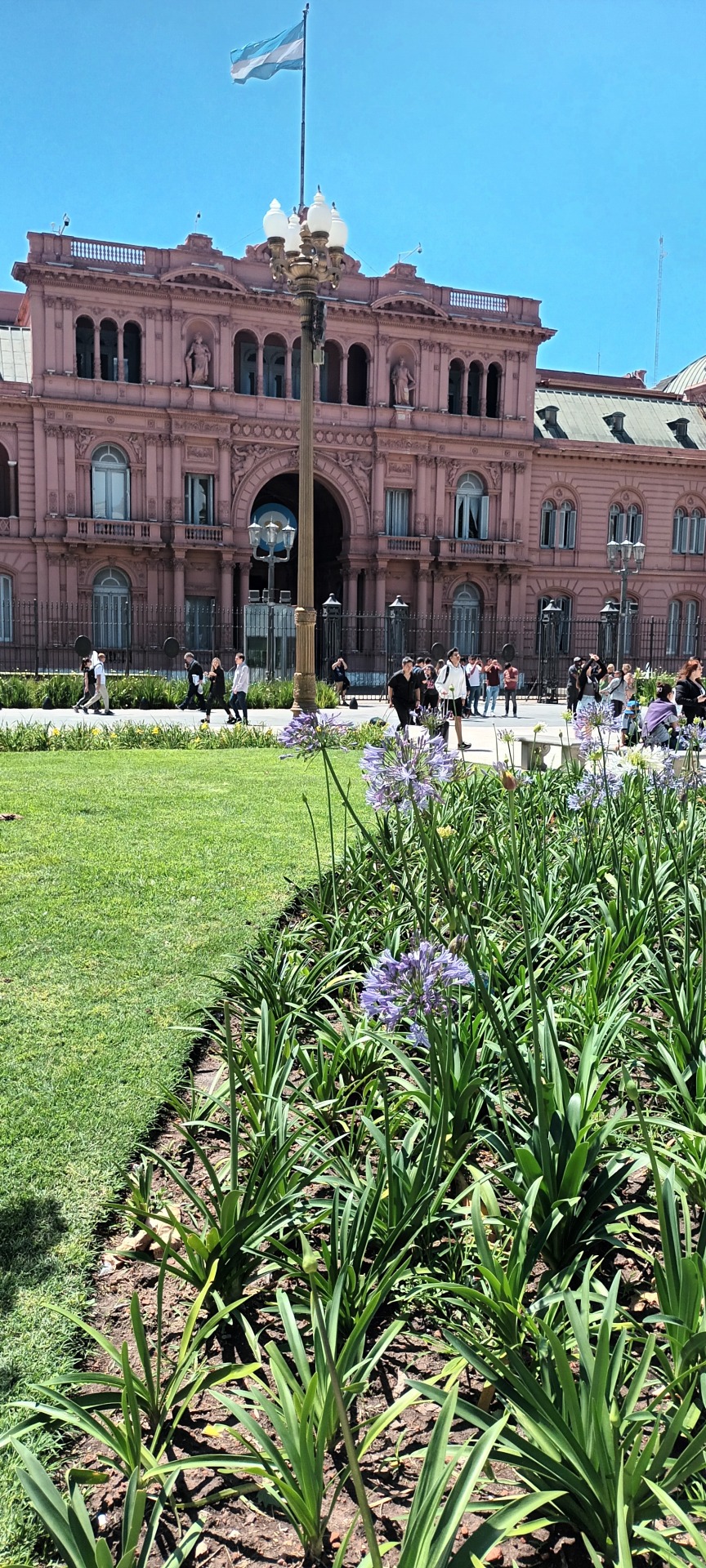
Eccellente caffe da “Pertutti”: bar sontuoso, sembrava di essere al S. Carlo di Torino.
Lasciamo B.A. per volare a El Calafate e visitare il Parque Nacional “Los Glaciares”, dove sono presenti tre diversi ambienti:
l’alta montagna, con i famosi ghiacciai Perito Moreno e Upsala
il bosco andino-patagonico, con foreste di Lenga e Nire
la steppa patagonica, settimo maggior deserto del mondo.
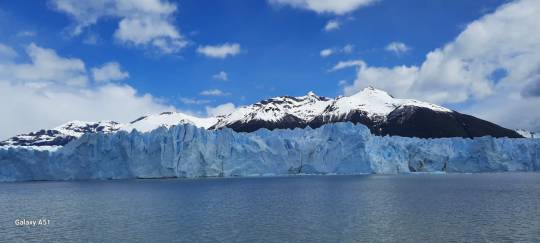
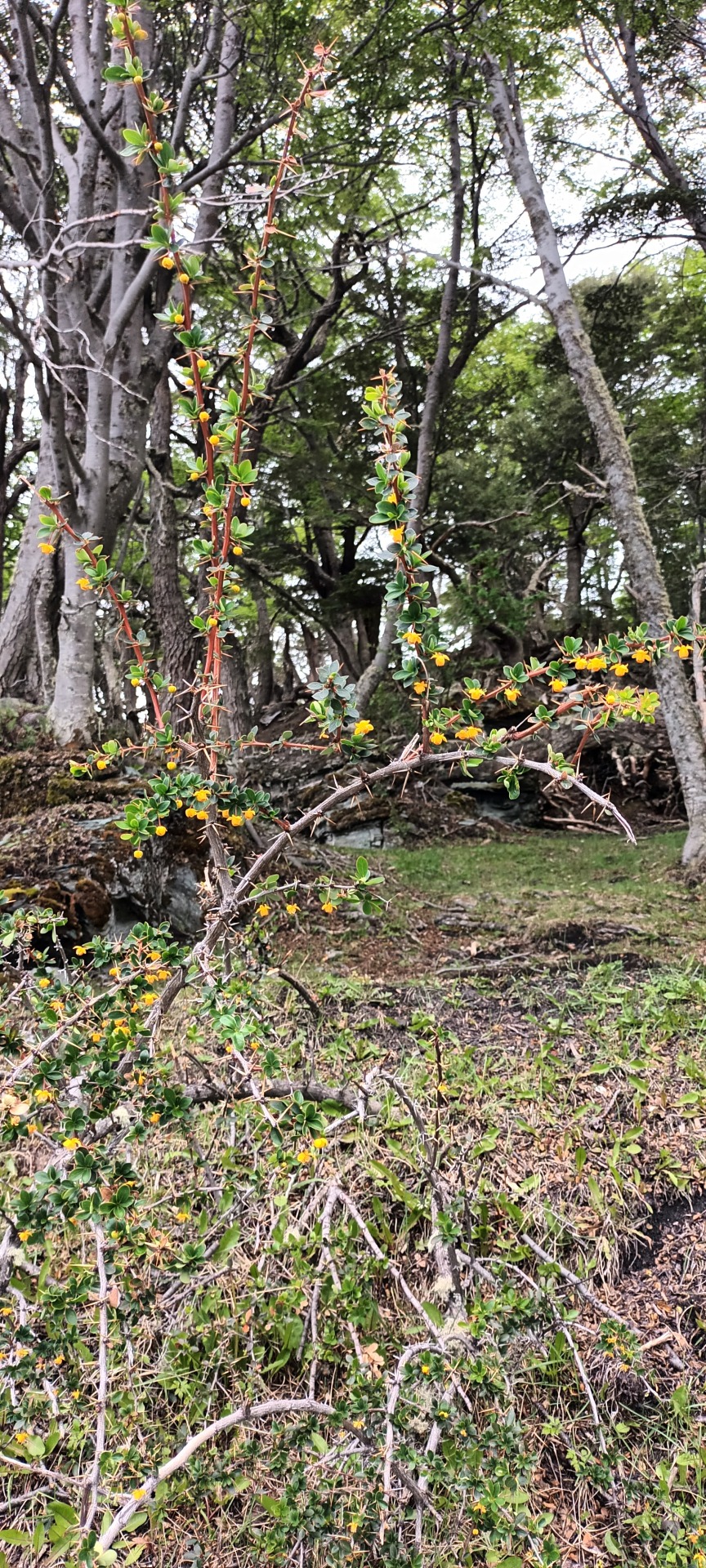
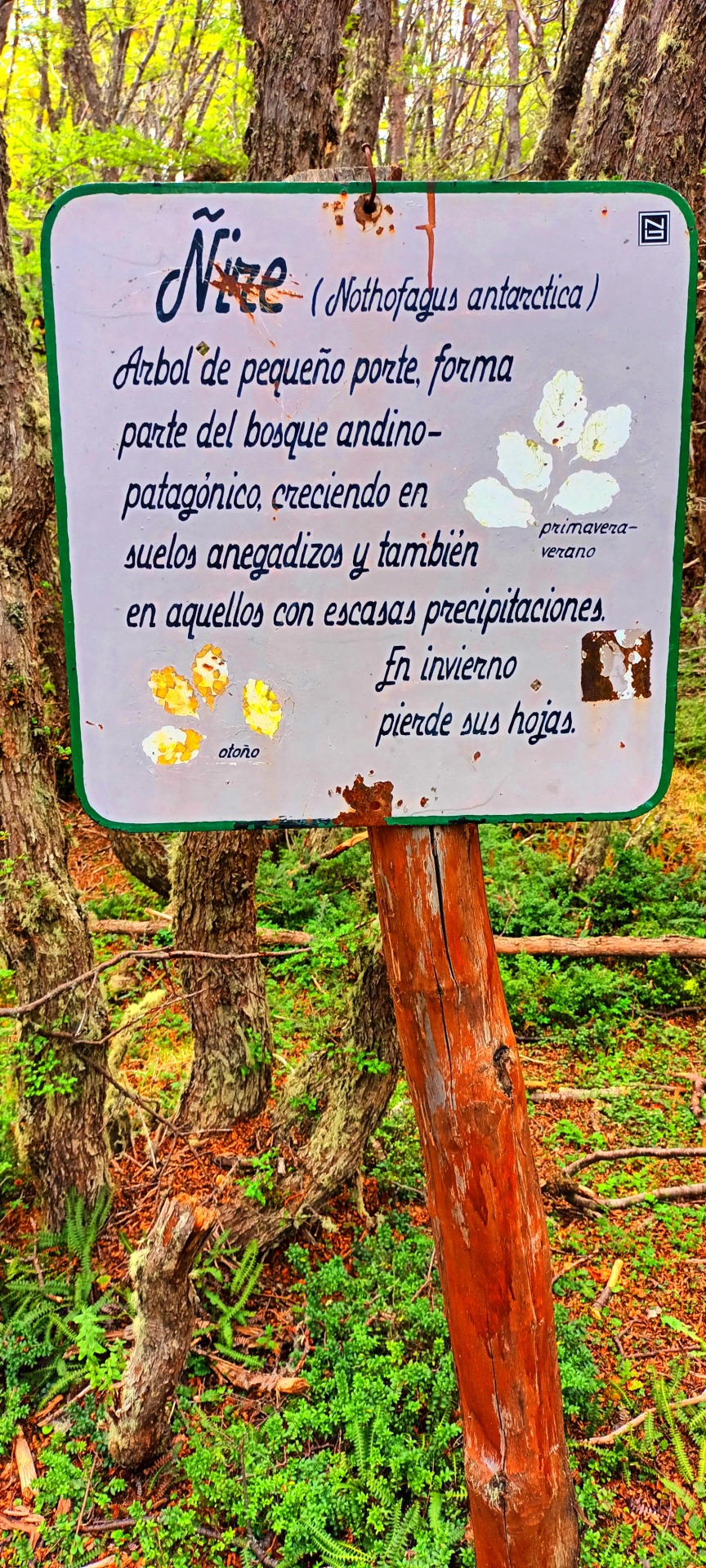

Partiamo per escursione d’intera giornata “Todo Glaciares”, navigando il lago argentino tra gli iceberg, con sosta per il lunch alla base Spegazzini.

Successiva tappa: Ushuaia. Sorvoliamo lo stretto di Magellano e raggiungiamo questa perla di città ai confini del mondo.

Qui, sotto l’ottima guida di Mariano, visitiamo il parco nazionale “Tierra del Fuego”, dove i primi abitanti, gli indios Ona, usavano accendere grandi fuochi, da cui il nome dato dai primi colonizzatori.
Segue la navigazione sul canale di Beagle, dove ammiriamo le colonie di leoni marini e di cormorani.


Al 9° giorno voliamo a Trelew e raggiungiamo Puerto Madryn. visitiamo quindi la Peninsula Valdes, dove alla Estancia S. Lorenzo possiamo camminare in mezzo alla più grande colonia di pinguini del continente.
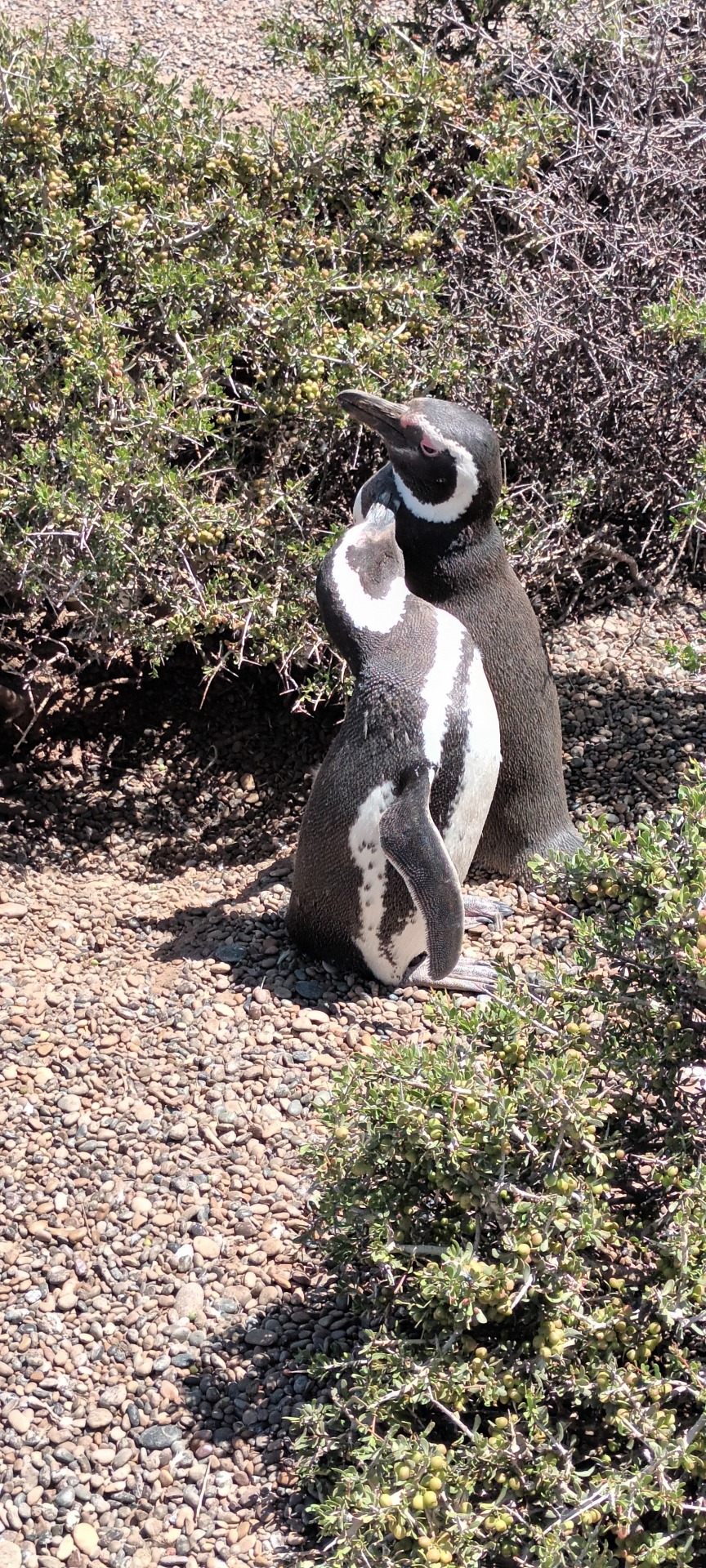
Al tramonto ci imbarchiamo a Puerto Piramides per ammirare le balene: eccitante, ma un freddo boia!
Il 4° volo è per le cascate di Iguazù. Le ammiriamo da sopra e da sotto, dal versante argentino e da quello brasiliano: una meraviglia!

Concludiamo la nostra vacanza con la visita ai quartieri sud di Buenos Aires, S. Telmo e La Boca.

Alla sera non possiamo mancare lo spettacolo del tango.

È stato un viaggio magnifico, anche se molto stancante, organizzato dall’agenzia Etlim di Imperia per un gruppo di 22 persone con cui ci siamo trovati bene. Il viaggio è durato 15 gg., di cui 2 di viaggio con Argentina Aerolineas, durata 14 ore (-4 all’andata + 4 al ritorno).
Oltre ai bei ricordi ci portiamo a casa anche quattro riproduzioni di un artista argentino che esponeva a Ushuaia.

I DREAMED IT FOR YEARS, BEFORE AND AFTER THE CORONA VIRUS.
AT LAST WE DID IT, GIAMPIERO AND I.
FIRST BUENOS AIRES: THE BEATING HEART OF THIS COUNTRY, ALMOST 3 MILLION SQUARE KM. LARGE.
IN THE NORTH OF THE CITY WE VISITED THE WEALTHY NEIGHBORHOODS OF PALERMO AND RECOLETA, IN WHOSE CEMETERY RESTS EVA PERON.
THEN PLAZA DE MAYO WITH THE CASA ROSADA, THE PARLIAMENT AND THE CATHEDRAL, FROM WHICH POPE FRANCIS COMES.
EXCELLENT COFFEE AT “PERTUTTI”: SUMPTUOUS BAR, WE FELT LIKE BEING AT THE S.CARLO IN TURIN.
WE LEAVE B.A.TO FLY TO EL CALAFATE AND VISIT THE PARQUE NACIONAL LOS GLACIARES, WHERE THERE ARE THREE DIFFERENT ENVIRONMENTS:
THE HIGH MOUNTAINS, WITH THE FAMOUS GLACIERS PERITO MORENO AND UPSALA
THE PATAGONIAN-ANDEAN FOREST, MOSTLY COVERED BY LENGA AND NIRE TREES
THE PATAGONIAN STEPPE, THE 7TH WIDEST DESERT IN THE WORLD.
WE HAVE A FULL-DAY EXCURSION CALLED “TODO GLACIARES” SAILING ON THE ARGENTINE LAKE AMONG THE ICEBERGS AND STOPPING FOR LUNCH AT THE SPEGAZZINI BASE. NEXT STOP: USHUAIA. WE FLY OVER THE STRAIT OF MAGELLAN AND REACH THIS PEARL OF A CITY AT THE EDGE OF THE WORLD.
HERE, UNDER THE VERY GOOD GUIDANCE OF MARIANO, WE VISIT THE NATIONAL PARK “TIERRA DEL FUEGO”, WHERE THE FIRST INHABITANTS, THE INDIOS ONA, USED TO LIGHT BIG FIRES, HENCE THE NAME GIVEN BY THE FIRST COLONIZERS.
THEN WE SAIL ON THE BEAGLE CHANNEL, WHERE WE ADMIRE THE COLONIES OF SEA LIONS AND CORMORANTS.
ON THE 9TH DAY WE FLY TO TRELEW AND WE REACH PUERTO MADRYN. WE THEN VISIT THE PENINSULA VALDES, WHERE AT THE ESTANCIA S.LORENZO WE WALK AMONG THE BIGGEST COLONY OF PENGUINS IN THE CONTINENT.
AT SUNSET WE GO TO PUERTO PIRAMIDES TO ADMIRE THE WHALES: EXCITING, BUT FREEZING COLD!
THE 4TH FLIGHT IS TO IGUAZU WATERFALLS. WE ADMIRE THEM FROM ABOVE AND BELOW, BOTH SIDES (ARGENTINEAN & BRASILIAN): A WONDER!
WE END OUR TRIP WITH A LAST TOUR IN B.A., THIS TIME TO THE SOUTHERN PART OF THE CITY: S. TELMO AND LA BOCA. AND IN THE EVENING WE CAN’T MISS THE TANGO EXHIBITION.
IT WAS A MAGNIFICENT JOURNEY, ALTHOUGH VERY TIRING, ORGANISED BY THE ETLIM AGENCY IN IMPERIA. WE WERE A GROUP OF 22 PEOPLE, WE HAD A GOOD TIME. IT LASTED 15 DAYS, 2 OF WHICH TRAVELLING WITH ARGENTINA AEROLINEAS FOR 14 HOURS (-4 TO GO + 4 TO COME BACK)
IN ADDITION TO THE GOOD MEMORIES, WE TOOK HOME FOUR REPRODUCTIONS OF AN ARGENTINE ARTIST WHO EXHIBITED IN USHUAIA.
6 notes
·
View notes
Text
5 JOURS EN BRETAGNE

PREMIER JOUR: LORIENT


DEUXIEME ETAPE: BREST.
La Recouvrance, un des plus grands ponts mobiles d’Europe

DINER A LA MAISON D’OCEANE
ET APRES : BRIEUC


4ème jour: RENNES, la capitale
SES MAISONS EN BOIS

ENFIN NANTES

LE CHATEAU DE DUCS DE BRETAGNE

4 notes
·
View notes
Video
tumblr
KEUKENHOF
Is there anything better in Spring than a trip to Amsterdam to enjoy the blooming tulips?

And if you have duly reserved,, the Rijks Museum is worth a visit too.
0 notes
Text
UNA VEZ MAS A VALENCIA

Valencia la hermosa!
Un fin de semana a Valencia siempre vale la pena, y por 5 Italianos qui quieren celebrar los 70 anos de sus carinos aun mas.
Sus 3 puntos fuertes:
Su vegetacion: los jardines del Turia en primer lugar y luego las avenidas, las plazas que incluso en julio son agradables, sobre todo si te refrescas con un vaso de agua de Valencia
Hotel Vincci Plaza: muy céntrico y acogedor, habitaciones amplias y tranquilas

Y finalmente el incomparable Restaurante Marcellina, de cara al mar, donde se come la mejor paella del mundo!

El museo Oceanografico? Regular, esperaba mas, le falta un poco de organizacion, pero las 3 hermanas estaban felices de todos modos!

P.S.La primera foro es del Museo de la Seda
0 notes
Text
Viajes y libros, viaggi e libri

ISABEL ALLENDE: LARGO PETALO DE MAR (LUNGO PETALO DI MARE) 2019
Isabel Allende, nacida en 1942 en Lima (Perù), pasó sus primeros anos en Chile y se exilió en Venezuela después del Golpe, cuando su tío Salvator Allende fue asesinado en 1973.Ahora vive en California (USA) y se define una “eterna extranjera”
Es la escriptora viva más leida del mundo de la lengua española.
Entre sus libros mas bonitos y traducidos en 43 idiomas, recuerdo:
-La casa de los espiritus (1982) novela de la que hicieron la magnifica
pelicula “The house of the spirits”, 1993, con
Meril Streep y Antonio Banderas
-Eva luna (1987) novela
-El plan infinito (1991) “
-Paula (1994) obra autobiográfica
-Retrato en sepia (2000) novela
-Inés del alma mía (2006) novela histórica
-El amante japonés (2015) novela
-Mas allá del invierno (2017) “
Il suo ultimo romanzo “ Lungo petalo di mare” ci riporta alla memoria due recenti terribili dittature: quella di Francisco Franco, in Spagna, durata ben 36 anni dalla fine della Guerra Civile nel 1939 alla morte del Caudillo nel 1975; e quella di Augusto Pinochet, in Cile, che a seguito del Colpo di Stato del 1973 prese il potere e lo mantenne fino al 1990.
“Largo petalo de mar” nos cuenta sobre el viaje transatlántico que organizó el poeta Pablo Neruda a bordo del Winnipeg, para que 2200 españoles pudieran llegar a Chile para escapar de la dictadura, considerando que la vecina Francia no los quería.

Nel 1939 il giovane dottore Victor Dalmau e la pianista Roser Bruguera, incinta del figlio di Guillem, morto nella guerra civile, fuggono da Barcellona e si rifugiano in Francia. Nello stesso anno, grazie a Pablo Neruda, riescono a partire per il Cile con tanti altri esuli e a rifarsi una vita. Ma destino vuole che circa 30 anni dopo siano sopraffatti da un’altra dittatura, quella del Gen.Pinochet, dunque costretti ancora a fuggire, questa volta in Venezuela.
Il Venezuela accolse Victor con la stessa spensierata generosità con cui ospitava migliaia di immigrati provenienti da diverse parti del mondo e più di recente gli esuli della dittatura del Cile e della Guerra Sucia in Argentina e Uruguay...Per Victor, che veniva da un Cile sobrio, prudente, perbenista e represso dalla dittatura, quell’ allegria indisciplinata fu scioccante.
“Rilassati, Victor” gli disse Roser.” Tenere sempre il broncio non serve a niente. Il dolore è inevitabile, ma la sofferenza è facoltativa”

1 note
·
View note
Text
SUMMER 2020: ITALIANS SPEND THEIR HOLIDAYS IN THE SOUTH OF ITALY
Il turismo in Italia sta soffrendo per la pandemia, una buona ragione per passare le vacanze nel nostro Paese: aiutiamo l'economia, che soffre per la scarsa presenza degli stranieri, e al contempo ci godiamo la bellezza delle nostre regioni del sud.
As the majority of Italians we leave for the two southern regions we haven’t seen yet: Calabria and Basilicata. Besides the beauty of the landscape we discover their efficiency - very good roads, well organised resorts - and surprising modernity: e.g. the column for refueling electric cars in a remote mountain village.

We join our friends, who own an apartment in Aieta, a remarkable village in the north of Calabria, and have accepted our four days self-invitation.

We choose to travel by car. The 1.100 km trip from Piedmont takes about 12 hours, most of them spent on the Autostrada del Sole. Cesare e Donata ci accolgono nel loro bell’ attico dove ceniamo e godiamo di un lungo sonno ristoratore.

The following day we drive to Mormanno, a nearby village that we want to see for family reasons: nonna Noemi è nata lì e poi emigrata al nord circa 60 anni fa. Notevole la cattedrale barocca.

Proseguiamo quindi per Morano Calabro, where we picnic in the pine forest under the Swabian-Norman castle.

Il giorno dopo andiamo a Maratea per vedere la statua del Cristo Redentore; il giorno prima, ci dice l'autista della navetta che ci porta in cima al Monte Biagio, ben 3500 turisti sono saliti a visitare la colossale scultura.

I nostri amici ci portano poi alla loro spiaggia preferita, il Villaggio Foresteria Illicini, affascinante resort che si estende su un parco di due ettari, servito da diverse discese a mare.

Mercoledì spiaggia di Praia a Mare, di fronte all’isola di Dino, a jewel of the Tyrrhenyan Sea.
Here too it’s full of tourists. We swim to the famous caves, among them Grotta del Leone, which is like an aquarium.
In the evening we dine at Il Saraceno, where we are served tasty food on a terrace that enjoys a magnificent view to the Gulf of Praia a Mare.
Giovedì lasciamo i nostri amici e la Calabria per recarci a Matera, nella vicina Basilicata.
Abbiamo prenotato all’Infinito dei Sassi, che si rivela essere una perfetta location tra il Sasso Caveoso e il Sasso Barisano.

La visita con la guida Antonio di Altieri Viaggi si rivela molto interessante.
A conclusione, simpatica degustazione dei prodotti tipici, tra cui le fave fritte salate e la liquirizia.
At the sunset we drive to the Altopiano delle Murge, a plateau of rectangular shape that extends from Puglia to Basilicata and in its western side is just opposite to Matera.
1 note
·
View note
Text
Il modello italiano Corona Virus

Vivo in una cittadina della provincia di Cuneo, Piemonte, dove la popolazione sta seguendo scrupolosamente le regole e che, fortunatamente, registra finora pochi casi di Covid 19. Tuttavia, in quanto over 65, da 4 settimane sono obbligata a stare in casa e a lavarmi spesso le mani.
Ho stampato le autocertificazioni dei decreti 8 marzo, 9 marzo, 16 marzo e 26 marzo che porto con me le poche volte che esco, in caso di controlli.
Due le notizie dell'ultima ora:
In TV le Istituzioni ci dicono, non senza un certo trionfalismo, che i Paesi Europei, l'America, forse la Russia stanno “copiando” il modello italiano, stanno cioè importando le procedure messe in atto dal nostro Governo per combattere il Corona Virus. L'O.M.S. ci considera degli eroi per le misure restrittive che una democrazia come la nostra è riuscita a mettere in campo e a far rispettare.
Però il modello italiano ha prodotto la percentuale più alta di morti rispetto al numero dei malati. Finora nessuno ha sottolineato questo controsenso. Ricapitoliamo.
Nella prima settimana di marzo in cui gli anziani erano già tutti chiusi in casa, gli altri 40 milioni di Italiani- meno i confinati delle zone rosse di Codogno e Vò- quindi i giovani in vacanza, gli adulti al lavoro e sui mezzi di trasporto pubblici, nei supermercati coi figli, hanno evidentemente fatto circolare il Covid-19 nella nostra penisola, anche da nord a sud, grazie alla fuga di notizie sul 2° decreto restrittivo del Presidente del Consiglio.
Poi è venuto il 3° decreto, perché il Governo si è ricordato che a casa erano confinate migliaia di persone infette da Corona virus, ma asintomatiche. Su questa moltitudine di potenziali diffusori di epidemia nessun controllo, negli ospedali si è lavorato con scarsità di mezzi, i medici e gli infermieri si sono ammalati e sono andati in quarantena. Cosa ha fatto il Governo invece di controllare gli infetti asintomatici, fare il tampone a medici e infermieri, fornire tutti di mascherine? Continua a raccomandarci di chiuderci in casa e di lavarci le mani.
Come si evince le misure che sono state adottate in Italia contro il Covid-19 sono tutt'altro che un modello da imitare. Abbiamo operato, come tutti gli altri paesi Europei e l' America, per tentativi ed errori, e ieri sera a Report abbiamo appreso che si poteva fare molto prima e molto meglio, ma è andata così!
2. L'altra notizia è di oggi: ci dice, come tutti già pensavamo, che le restrizioni continueranno almeno fino a Pasqua, e sempre in tutta Italia, perché si continua a considerare le zone dove ci sono migliaia di nuove infezioni al giorno e centinaia di morti, allo stesso modo di quelle dove il contagio è basso. Si è arrivati anche a proibire le attività fisiche all'aperto.
Pochi giorni fa in TV hanno mostrato un Vigile che redarguiva alcuni adolescenti che giocavano a pallone in un prato, ora si dice che per questi reati è prevista anche la reclusione.
Così al dramma della pandemia si aggiunge il panico di essere fermati e redarguiti da poliziotti e vigili zelanti che ti colgono in flagrante durante la tua mezz' ora d' aria a giorni alterni ( purtroppo non hai un cane e allora come giustificare la passeggiata?) o quando prendi il coraggio a due mani ed esci dal comune per visitare i genitori anziani (non certo senza 2 borse della spesa perché solo così puoi giustificare!) Ma davvero nessuno considera in tempo di Corona virus i danni psicologici causati a milioni di persone sane private della loro libertà? Un mio vicino di casa adolescente di notte si sveglia e grida perché crede che i suoi genitori siano morti. E' la conseguenza di giorni e giorni passati a sentire in sottofondo, mentre fa i compiti, i bollettini di guerra che in TV , di ora in ora, danno i numeri dei decessi. Secondo voi tutto questo è normale?
Nessuno fa presente che la TV sta esagerando, che basterebbero due notiziari al giorno invece di RAI News 24 + continui, martellanti talk shows?
Oggi il Premier, che ammiro nonostante tutto, ci dice che la chiusura delle scuole prevista fino al 3 aprile sarà prorogata. Ma se l'OMS ci dice che la percentuale di infezione da Corovid19 sui bambini è dello 0,02%, perché non far ritornare a scuola almeno gli alunni di Infanzia e Primaria? Perché continuare a segregare in casa milioni di bambini, privarli della loro sacrosanta routine, dei loro compagni, dei loro giochi? E gli anziani in Casa di Riposo delle visite dei loro cari? Certo con tutte le raccomandazioni del caso, le protezioni individuali da parte di tutto il personale che opera nelle Istituzioni pubbliche e private. Sarebbe anche una prova di fiducia nel senso di responsabilità di tutti i cittadini italiani.
1 note
·
View note
Text
Lettre à Martine
Lundi 25 novembre 2019
Salut mon amie, cette nuit je t'ai rêvée.
J'avait trois tickets pour le théâtre et je vous ai invités, toi et ton mari.
On était à Milan, sur l'autobus; Pierre portait un beau manteau bleue, mais il était inquiet parce qu'on était déjà en retard et le bus s’arrêtait tous les moments.
Puis, soudain, je me suis réveillée.
Et j'ai immédiatement pensé au voyage en voiture de hier, que Jean Pierre et moi avons fait pour venir de Juan Les Pins à Cuneo, et cela n'était pas un rêve.
Mon beau-père est à l’hôpital depuis quelques jours, rien de grave mais il a quand même 93 ans. C'est pour ça que, nonobstant l'alerte rouge sur les Alpes Maritimes, on a renvoyé notre voyage à Lyon (dommage, Geneviève et Olivier nous attendaient) et quitté la Cote d'Azur pour nous rendre en Italie.
Normalement on fait le Col de Tende, mais à cause de la pluie et peut- être de la neige, on a décidé de prendre l'autoroute Savona/Turin, un trajet plus longue et coûteux, mais plus sure.
Il y avait peu de trafic et on est arrivés sain et sauf à Cuneo vers midi.
Un fois terminé la visite à l’hôpital on est remontés en voiture pour joindre notre maison à Cherasco, et c'est à ce moment là qu'on a appris par radio que un gros éboulement était précipité sur l'autoroute A6, en produisant la chute d'un viaduc près d'Altare.
Un incident terrible, qui nous rappelle celui du pont de Gênes il y a 14 mois et qui a fait 43 victimes.
On a immédiatement fait des recherches sur internet, en découvrant que, heureusement, il n'y avait de victimes; toutefois sur un vidéo posté par les sapeurs-pompiers, on voyait une file d'autos et un bus qui s’étaient arrêtés juste avant le gouffre.
Inutile te dire que si on entamait notre voyage 3 heures plus tard, je ne serais pas là à te raconter.
Je viens de lire un beau livre intitulé «La mattina dopo» (Le matin après) écrit par le journaliste italienMario Calabresi.
Il réfléchit sur le conséquences des drames qui peuvent soudain s'abattre sur nous ou sur nos proches, en bousculant notre vie pour toujours.
La mort d' un fils, de ton époux, d'une chère amie, aussi bien que la perte du travail ou d'un gros investissement, un feu qui te brûle la maison, un tremblement de terre ou une inondation: d'un moment à l'autre ta vie est détruite.
Le matin après les gens n'arrivent pas à croire que tout est vrai, qu'on a vraiment perdu notre bien aimé ou le choses qu'on possédait depuis toujours.
Si seulement c’était un rêve, si soudain on se réveillait et tout était comme avant...
3 notes
·
View notes
Text
HO IMPARATO - I HAVE LEARNT
by Enrico Letta (2019, Il Mulino)

According to Enrico Letta, former Italian Prime Minister and now Director of the International School of Political Science in Paris, the year 2019 is really crucial for Europe.
In fact our continent is marked by some extraordinary events that, in a positive or negative way, will change Europe forever.
First of all: Brexit. We don't yet know how the procedure will go down, as there is no similar prior experience. Since the Treaty of Maastricht in 1992, the European Union has always grown, going from 6 to 28 countries. This year, for the first time ever, a country as important as the United Kingdom will leave. How will this event change the E.U.?
Then in Spring we had the Parliament Elections, whose first effects will be seen in the coming months.
Top issues that made citizens vote with the highest participation since 1994, particularly in the age group of 25-39, were mainly economy and growth, climate change and human rights.
But also the potential danger that some nationalist countries, among them Italy, supported by Trump and Putin, could definitely destroy the E.U.
Thank God the parties against the European Union have failed, and in the Parliament 2019-2024 the EPP (Christian Democrats) and S&D (Alliance of Socialists and Democrats) continue to be the majority (336 on 751 seats); a good news, though, is that the third party is Renew Europe, as many changes have to be made. The commitment of the new course is “the way the EU should be working in the future”.
When this book came out we all ignored that the new President of the European Commission would be, for the first time, a woman: Ursula von der Leyen. On her election day she made quite a promising speech in which we learnt that she will start focusing on the two issues that not only affect Europe but the entire world: climate and immigration.
Last but not least, 2019 will have, according to Enrico Letta, a third significant event: all most important European leaders will leave, and among them the most important one is the turnover of the European Central Bank President Mario Draghi.
We all know that if the German Axel Weber had been elected in 2011, the E.U. would have probably lost its common currency, the Euro.
Now that we have a new ECB President, we all look at Christine Lagarde (at least I do) with confidence and hope.
“Ho imparato” ends with Enrico Letta returning to the Italian scenery and suggests how to renovate our political class through four cardinal points:
in the north, he puts opening “in terms of relations with the outside, with the world of skills and with social representatives. Parties must have more contacts with foreign nations in order to identify good practices and import them into Italy”
in the south he sees reliability: “to have few and clear rules for making the party live and respecting them, starting from the most simple practices such as fixing meetings in manageable hours for everyone”
the east and west of his compass are competence and roots: “policy training must be mandatory and it is also essential to reward those who are committed to their community”
I found this book interesting, simple to understand, honest. I recommend it, especially to young people often worried about their future: they will find a seed of hope in it.
1 note
·
View note
Text
Viaggi e libri , books & travels, livres et voyages, libros y viajes

HO LETTO QUESTO LIBRO E MI E’ PIACIUTO.
Osservazioni:
Nel 2015 Enrico Letta, già Primo Ministro defenestrato da Matteo Renzi con la famosa frase “Stai sereno!” si dimise dalla Camera dei Deputati per andare a dirigere la Scuola di Politiche Internazionali presso l'Università di Parigi.
E' piuttosto raro che un politico di primo piano si dimetta da una carica importante per andare ad insegnare, almeno lo è in Italia dove insegnare non è considerato una professione prestigiosa, visto che i nostri docenti sono tra i più mal pagati in Europa.
Evidentemente Enrico Letta era così deluso da come le cose stavano andando in Italia e in particolare nel Partito Democratico, che decise di cambiare mestiere e oggi, grazie alla soddisfacente esperienza che ha vissuto e vive, arriva addirittura nel suo libro a ringraziare Matteo Renzi.
Quando si dice trasformare le crisi in opportunità...
In Ho Imparato l'autore afferma che viviamo in Italia una stagione politica molto deprimente, iniziata una decina di anni va con i vaffa di Beppe Grillo, continuata con la rottamazione di Matteo Renzi ed infine sfociata nelle ruspe di Matteo Salvini.
E' inevitabile che la tracotanza e il cattivo gusto dei nostri leader vengano imitati dalla gente comune e così la società civile non è più civile e assistiamo ogni giorno ad un crescendo di violenza sia verbale che fisica ovunque, negli ospedali come nelle scuole, per non parlare del cyber bullismo e dei maltrattamenti contro gli individui più deboli: i bambini, le donne, gli extracomunitari.
Nel primo capitolo del libro Enrico Letta ci parla del “Villaggio globale” pubblicato sulla “Domenica del Corriere” nel 1966, anno della sua nascita.
Allora la popolazione globale era di 3 miliardi, che la vignetta traduce in 100 persone suddivise in 5 gruppi: al centro del disegno ci sono gli europei, che sono una ventina. In alto a sinistra gli asiatici, una cinquantina. In basso a destra gli africani, una decina e nei due angoli opposti gli americani del nord e del sud, una ventina di persone.
L'autore rielabora quindi il disegno secondo le previsioni demografiche che indicano in 10 miliardi la popolazione del nostro pianeta nel 2050. Sempre fatto cento il numero delle persone rappresentate nella nuova vignetta, i dati che restano costanti sono i 50 asiatici e i 20 americani.
Gli africani invece da 10 diventano 25 e gli europei passano da 20 a 5.
Ne derivano per l'autore 3 riflessioni:
-la questione dell'ambiente e delle risorse, finalmente oggi al centro dell'attenzione mondiale grazie a Greta (probabile Nobel per la pace). Il futuro dei nostri figli e della nostra stessa civiltà dipende dagli accordi globali sul clima e sui consumi che bisogna attivare subito: se la Terra è sempre quella e dovrà a breve sfamare il triplo della popolazione cosa aspettiamo a prendere seri provvedimenti?
-l' incidenza nel mondo di noi europei passerà da un quinto a un ventesimo, dunque conteremo sempre di meno. Se vogliamo annullarci del tutto, avanti coi nazionalismi e il respingimento degli extracomunitari!
-la realtà del 1960 e quella del 2050 corrisponde all'arco di una vita, perciò ciascuno di noi, con i suoi pensieri e le sue azioni può fare la differenza.
2 notes
·
View notes
Text
A Family Flotilla in Greece
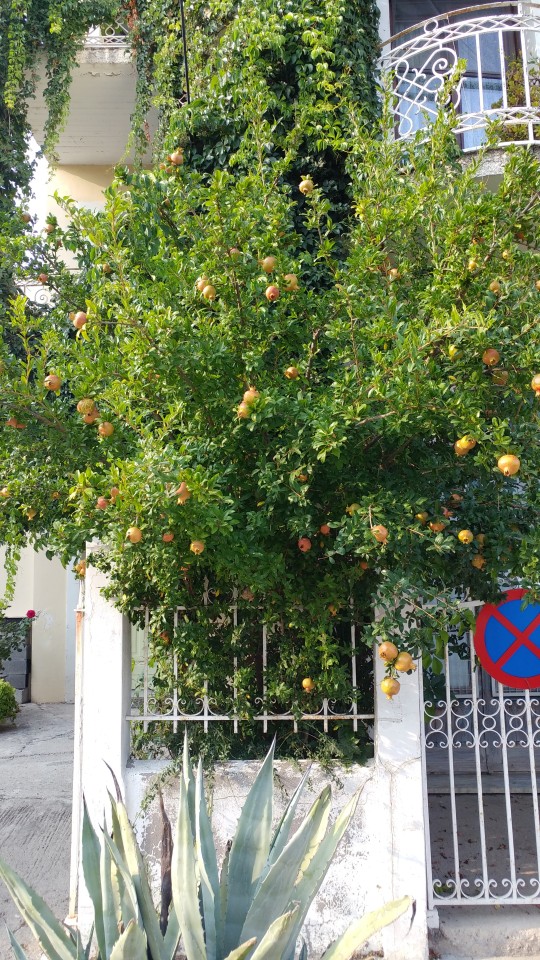
Here is the report of our 15-day flotilla in the Ionian Island.
The Family Flotilla is organised by Maurizio Anzillotti from Solovela.net with a special goal: to enjoy ourselves and at the same time to involve children aged 8/15 in a two-week sailing holiday.
We meet our flotilla in the port of Lefkas on July 27th, where we get our chartered boat, a Bavaria 30 Cruiser named Mojito at the Aquarius Yachts.
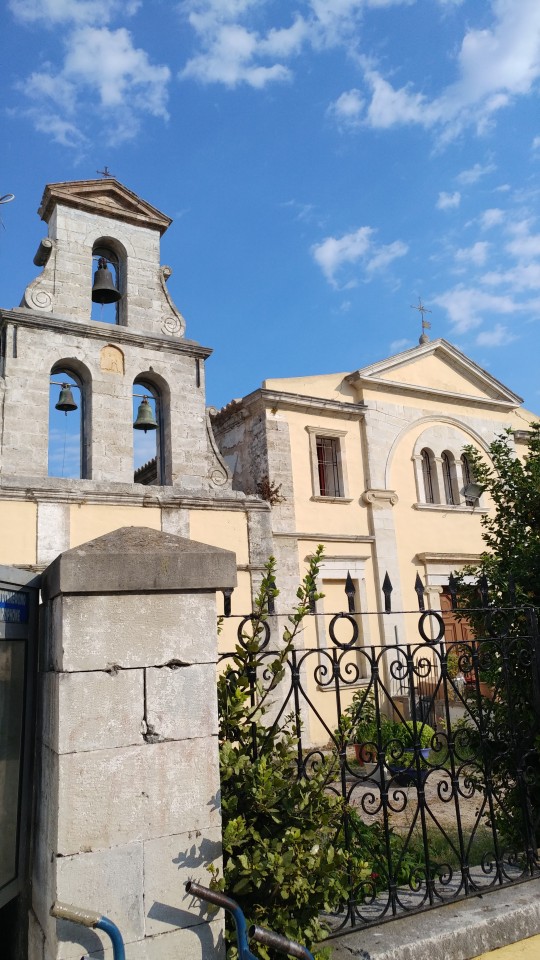
Three other boats check in at the same time, two in the Lefkas Marina, the third one in Preveza.
Later on at the restaurant we introduce ourselves:
Giampiero and I, no children along, from Cherasco, Cuneo on a Bavaria 30, the Mojito.
Maurizio and Nadia with Cloe and Chiara, later on also her fiancé Flavio, from Rome on a Bavaria 45, the Sophia.
Matteo and Francesca with Arianna and Gabriele from Rho, Milan on a Bavaria 40, the Philomela.
Marcello and Tiziana with Cristian and Bruno from Benevento, Naples on a Bavaria 37, the Sirius.
A 5th boat is due to join us on the 5th day of the cruise, an Amel 53, the Dory, with 5 people aboard: their owners Andrea and Liala with Giulia and their friends Massimo and Giovanna.
The Family Flotilla is therefore composed by 20 people,14 adults and 6 children on 5 sailboats.
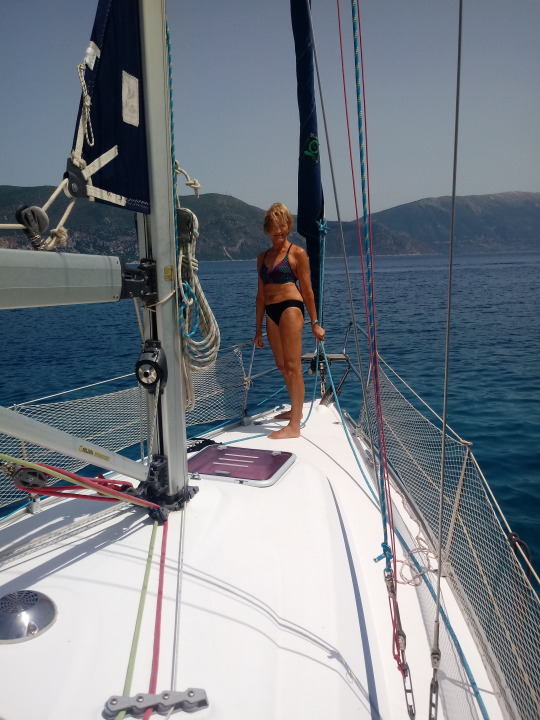
After a good meal (a delicious octopus and pasta al dente), we agree to meet the following morning at 10:30 in the channel, out of the port of Lefkas. Our first destination is Meganisi, a small island 15 miles away.
First day, first problem: as we leave the port, our Mojito's propeller catches an underwater line and the engine dies; we must then call a diver who eventually frees our boat and we can reach the flotilla waiting for us.
The cruise ends happily in a northern bay of Meganisi, where we all moor and then have a round of drinks on the Sophia.
The second day we leave early in the morning in order to stop for a swim before heading to the bay of St. Nikolaou, Itaca. For the second day all navigation is done by motor, as in the morning there is no wind and in the afternoon it blows right from the bow.

On July 30th a storm is announced for the evening and the following day, so we look for a safe harbor. As the main port of Sami, Kefalonia, is full, we have to moor in Ay Eufimia.
Under the guide of our head skipper Maurizio, after throwing the anchor, we tie the boats with lines on the ground and also among them.
Once we feel safe we reserve a table at the restaurant just above us, where we can keep an eye on the boats and at the same time eat and relax.
That evening we all realize that as long as Maurizio is with us we can sleep on two pillows: he has such a long experience with boats and sailing that no problem is unsolvable for him.
The following morning, again with no wind blowing, we reach Sami where we refill the water and the fuel (no electricity is available). After a good swim in a rather rough sea, a lot of fun for the children, the Flotilla separates: the majority go to the restaurant, the minority, us, dine on the boat, and later on we admire the starry, end of July night.

The 1st of August at midday we head north towards Fiskardho, being finally able to hoist the sails for a couple of hours. The mooring in the bay is not easy but eventually we find a good place, next to a path that leads to the harbor.
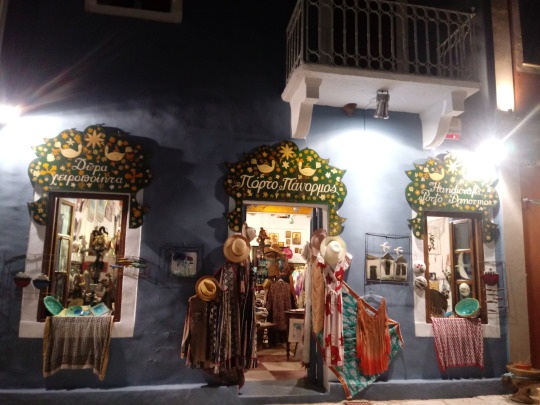
After dinner we walk downtown, where we see the spot where the movie “Captain Corelli's mandolin” was filmed (starring Penelope Cruz and Nicholas Cage); we then stop at a bar with a remarkable restroom with an aquarium in it and we have Uzo (the national Greek drink).
Being Fiskardho very nice, the Flotilla decides to stay there another day, just moving to the other side of the bay. In the afternoon we go and visit the Venetian lighthouse and the remains of a Roman basilica.
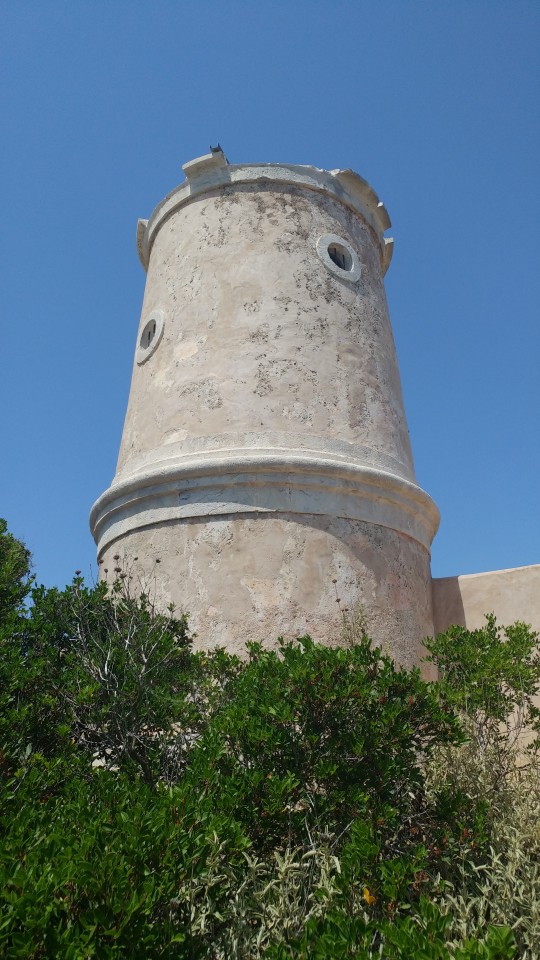
August 2nd is quite unfortunate. Our plan is to sail to Assos, a lovely village in the west side of Kefalonia, where we wish to visit the fortress and the remains of the monastery.
Because of the poseidonia, though, only the Philomela succeeds in anchoring, while the other four boats have to head back to Fiskardho.
During the trip the engine of Sophia suddenly breaks and Maurizio and his crew must find a way to reach the port. They manage to sail for a while and later on Marcello pulls them with Sirius into Fiskardo where a mechanic will repair the damage.
The following day we celebrate at the Panorama Restaurant the rescued Sophia, our lost dinghy found and collected by Matteo, the reunion of the whole flotilla.
While dining Matteo and Francesca tell us how beautiful Assos was, the island we promise not to miss next time.
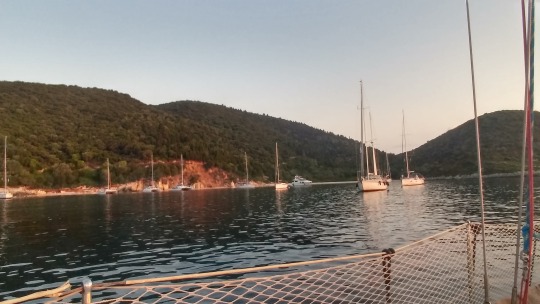
3 notes
·
View notes
Text
A Family Flotilla in Greece, part 2

On Sunday 4th we start the second week of the cruise sailing to Itaca and mooring in the same bay where we were a week earlier, in order to have a barbecue on the beach.
The Dori's crew invites us for a tour to the small island nearby, where a bell stands on St. Nikolaou church; in the meantime they show us how to use the dinghy.
Before dinner the Flotilla meets for an aperitif on the beach and enjoys the lovely “sangria with peaches” by Massimo & Andrea and “bollicine Falanghina” by Marcello.

On Monday 5th we try to dock to Atokos but there is no place for us, so we head towards Kastos where we stay for the night. After a walk to the mill and a drink in front of a magnificent view,


we decide to dine in the boat, while our friends go to the restaurant.
It turns out to be a good choice as a sudden strong wind moves the Amel towards the Mojito and pushes it against the Sirius. While Giampiero does the necessary to avoid a collision, Andrea quickly arrives and sets up his boat.
The following day we head to Kalamos, the smallest of the seven Ionian islands, and we moor in port Leone. This town was destroyed by the 1953 earthquake and abandoned. Today only a church stands in the port and many tourists come here to experience a really peaceful place.

On August the 7th we sail to the port of Vathi, Meganisi, in order to recharge our boats with fuel, water and electricity.
As once more there is no place in the port, we moor in the bay nearby, as suggested by Nadia.
Here Maurizio takes the Family Flotilla's memory picture, everyone wearing the same t-shirt, and then we rejoice for a warm shower and a sumptuous dinner.
We spend our last day in an another Meganisi bay and in the early afternoon we bid farewell to the the Dori's crew, as they will stay another two weeks in Greece.
We sail back to Lefkas, where we check out and have our last dinner, saying good bye to everyone.
The following morning we drive to Igoumenitza to take the ferry boat back to Ancona.

We found this experience satisfactory.
The most positive aspect was the good company of five experienced skippers and their brilliant wives.
It was also a pleasure to watch the kids enjoy every moment of the day: helping during the mooring (a special mention to Chiara and Flavio), swimming and diving, collecting shells and stones, fishing.
Never quareling, never bored, simply happy!
2 notes
·
View notes
Text
VALENCIA, EXCELENTE CIUDAD ESPANOLA

Hace muchos anos visité las ciudades mas importantes de España: Granada, Sevilla, Cordoba, Madrid, Toledo y, mas tarde, Barcelona.
Todos estos lugares me impresionaron para su belleza, pero ninguno me gustò como Valencia, donde pasé el ultimo fin de semana con mis hermanas.
Valencia tiene todo lo que un turista puede desear.

Para empezar, una estupenda arquitectura, gracias especialmente al archistar Calatrava y a su “Ciutat de les Arts y les Ciences”: nunca he visto construcciones tan majestuosas en mi vida!

En el complejo de los cinco edificios hay el Museo Oceanografico, que visitaremos la proxima vez y que solo merece el viaje.

Cuando empezó a llover nos refugiamos en la Catedral, que realmente merece una visita incluso con buen tiempo, porque alberga el Santo Caliz y unas de las mas preciosas obras del primer Renacimiento Español.

A través del recorrido del bus turistico pasamos del centro de la ciudad al mar (nos alojamos en el agradable hotel Senator Parque Central), donde domingo al mediodía asistimos a un magnifico concierto.
Entre el puerto y la marina hay “Veles y vents”, donde se puede comer un buen almuerzo en la terraza, servido por camareros realmente agradables.
Para la cena les recomiendo el antiguo y elegante restaurante “El Marcelin”, justo en la playa, donde se gusta la mejor paella de Valencia.

Ultimo pero no menos importante es caminar, correr o andar en bicicleta a lo largo de los jardines del Turia o, ¿por qué no? sientarse a la sombra de los grandes arboles de este parque que ha reemplazado el rio.
Amo a Espana y tal vez me vaya a vivir allí, estos días ya no me gusta Italia.
1 note
·
View note
Text
Travelling & reading
Danielle Steel, age 71, is an American writer, best known for her romance novels, with over 800 million copies sold.
Here is the summary of Five days in Paris as it is written on the cover of the book itself.

On the night of a bomb threat, Olivia and Peter meet accidentally in Paris. Their lives converge for a magical moment in the Place Vendôme, and in a café in Montmartre their hearts are laid bare.
Peter, once so sure of his marriage and success, is faced with the jeopardy of his professional career; Olivia, no longer sure of anything, knows that she cannot go on anymore.
A novel about honour and commitment, love and integrity, and about finding hope again.
As far as I'm concerned, I've been impressed by how much Peter loves Paris and how good Danielle Steel is in describing his feeling: Paris was special to him, it was the culmination of everything he had always dreamed, and never even knew he wanted… it was the perfect city. It always took his breath away. There was something about Paris that made his heart race. He had come here on business for the first time fifteen years before, and at the time, he had felt as though he had been put on earth for that single moment in time when he first saw it. He had arrived in Paris alone on a national holiday, and he still remembered driving down the Champs Elysées with the Arc de Triomphe straight ahead, and the French flag flying nobly in the breeze from inside the arch. He had stopped the car, gotten out, and as he stood there and looked at it, he had been embarrased to realize that he was crying.
My question is: would Peter have falled in love with Olivia if he had met her in Geneva or in New York, no matter how beautiful they are?
And when Olivia disappears, could she have gone to England or Germany? Not at all!
She hides in La Favière, a small village by the sea in the south of France. So Peter drives for an entire night from Paris to La Favière to look for Olivia, and they meet on the beach in a sunny day.
Would have he done the same if she was hiding, say, in Milan?
My answer is no, Peter wouldn't have followed Olivia if they hadn’t been in Paris and he wouldn't have fallen in love with her if they didn't met again in this lovely remote fishing village.
I believe love needs some help to blossom, and France is there to help.
1 note
·
View note
Text
Travelling & reading
Guillaume Musso, romancier français né en 1974 à Antibes, avec plus de 1.500.000 exemplaires vendus en 2017, il est pour la 7ème année consécutive l'auteur le plus lu en France.
Traduit en 41 langues, ses livres sont un mélange du roman sentimental, du suspense et du fantastique.

Un appartement à Paris est l'histoire de Madeline, une ex-flic londonienne et de Gaspard, un américain misanthrope venu à écrire dans la solitude sa prochaine pièce théâtrale.
Ayant loué par erreur le même appartement, ils essayent de se débarrasser l'une de l'autre sans y réussir.
Entre-temps ils découvrent que la maison cache un secret lié à son propriétaire, le célèbre peintre Sean Lorenz. Celui-ci vient de mourir et ses trois derniers tableaux ont mystérieusement disparus.
L'histoire se déroule entre Paris, où son agent lui loue tous les ans, pendant les vacances de Noël, un appartement pour écrire en tranquillité, et New York. Gaspard déteste tellement le trafic et la pollution de la capitale française, qu'il n'a aucun problème à se renfermer 24h sur 24 et en janvier sa nouvelle pièce est toujours prête. Il blâme les touristes qui viennent à la recherche de la Ville Lumiére- celle des cafés romantiques, des bouquinistes sur les rives de la Seine, de la butte Montmartre et de Saint-Germain-des-Prés et à sa place ils trouvent saleté, voleurs, insécurité, ravages urbains, insuffisance des transports publiques.
Tout à fait différente est la vision que Madeline a de Paris. En arrivant à la Gare du Nord elle trouve que l'endroit, même si considéré par la plupart des gens désordonné et effrayant, est un concentré d’énergie brute et contagieuse...Il s'agit d'un ruche en perpétuel activité. Milliers de vies qui se croisent tissant un géant toile d'araignée,..une vague de marée qu'il faut savoir dominer pour ne pas se noyer.
Pendant quelques ans Madeline avait habité Manhattan, mais New York l'avait finalement fatiguée et Paris demeurait sa ville fétiche où elle venait toujours à soigner ses blessures.
Évidemment il y a un de l'autobiographie dans ce livre, car Guillaume Musso, né à Antibes, lui aussi a vécu dans sa jeunesse à Manhattan mais en suite il s'est installé à Paris où il vit maintenant, et on comprend qu'il aime beaucoup cette ville, malgré ses défauts, comme la pollution, la pluie copieuse et, dernièrement, le danger du terrorisme islamique.
La force de ce roman se trouve, à mon avis, dans la dichotomie: la même ville, vécue de manière totalement différente par le protagonistes; deux personnes aux antipodes qui, au bout de l'histoire, se retrouvent amoureux.
1 note
·
View note